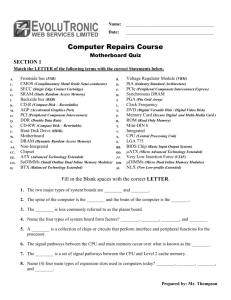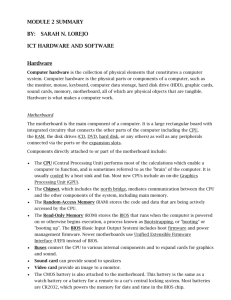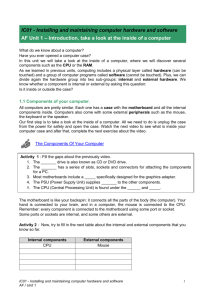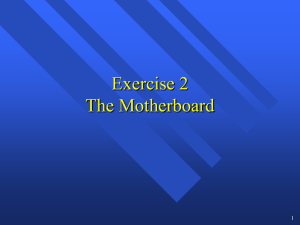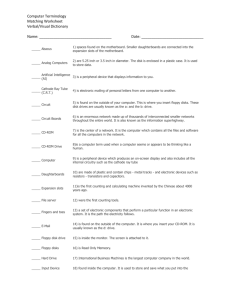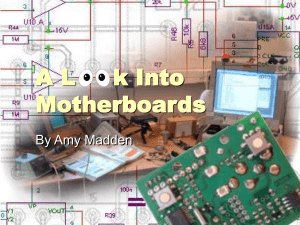Micro-L2b- Motherboard
advertisement
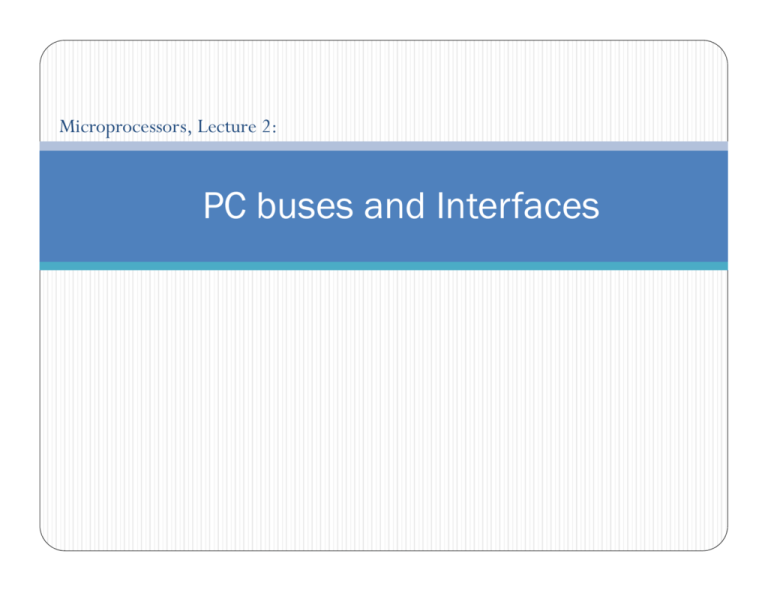
Microprocessors, Lecture 2: PC buses and Interfaces Introduction y The anatomy of a modern personal computer (PC) y Common PC buses and interfaces 2 Motherboard 3 Motherboard y In personal computers, a motherboard is the central printed circuit board (PCB) used to connect many of the system components. y All busses external to the CPU are on the motherboard y The motherboard includes connector sockets for the CPU and many I/O peripherals 4 Motherboard y Connects all the components of a computer together y Supplies power to (and allows data to flow among) all components y A series of different slots which cables and cards fit into y All parts are compatible with the motherboard else the machine will not work y In particular, the motherboard must be matched to the CPU, especially in the bus speed 5 Motherboard Components y The first IBM PC motherboard had only a processor and card slots y Users plugged components like floppy drive controllers and memory into the slots y Today, motherboards typically boast a wide variety of built-in features y On-chip storage and memory controllers, sound, network adaptor, modem, ….. 6 Motherboard Components y Some functionalities are added by expansion cards y Modem, sound, TV, Ethernet, graphics,…. 7 Common Motherboard Components y Processor socket: where processor is plugged in y BIOS: Basic Input/Output System, a chip that controls most basic y y y y y y y y 8 operations PCI and PCI-express slots: Peripheral Component Interconnect, for external devices AGP slot: Accelerated Graphics Port, dedicated port for video card SATA and IDE connectors: attachments for hard drives, by serial plug (SATA) or parallel ribbon (IDE) Clock Memory slots Northbridge and Southbridge: chipset that connect the processor to everything else Logic and connectors to control USB, PS2, serial port, parallel port, Ethernet LAN, audio …. Motherboard Components- 10 years ago BIOS Chip CMOS Battery AGP Expansion Slot LPT 1 Printer Port PS/2 Mouse& Ps/2 Keyboard Connector USB Port ATX Power Connector PCI Expansion Slots CPU Socket 370 DIMM Memory Sockets 9 ChipSet Floppy Drive Controller 9 Modern Motherboard Components 10 10 Very old motherboard components- grand-motherboard! Form Factor 12 Motherboard Form Factors y Determines motherboard size, features y Dimensions, power supply type, location of mounting holes, number of ports on the back panel y Ensure that parts are interchangeable across vendors and generations y Compatibility with power supplies, cases, expansion cards, … 13 Motherboard Form Factors y Most popular form factors: y ATX, MicroATX, FlexATX, BTX, NLX y AT is the oldest form factor introduced by IBM in the 80s y ATX and ATX-mini are the current popular standards y By Intel since 1997 y The latest update to the ATX standard was released in 2007 ATX: 305 × 244 mm ATX-mini: 244 × 244 mm ATX micro-ATX Motherboard Form Factors ATX motherboard 15 AT motherboard CPU Sockets 16 Processor Sockets y Where the CPU is inserted on the motherboard y Provides mechanical and electrical connections between a CPU and motherboard y Allows the CPU to be replaced without soldering 17 Processor Socket Types y Based on the CPU package type: PGA and LGA y Pin grid array (PGA) y Pins aligned in uniform rows around socket y Land grid array (LGA) y Uses lands rather than pins y The pins on the socket rather than the CPU 18 Processor Sockets y Zero Insertion Force (ZIF) sockets are used to keep chips y Side lever lifts processor up and out of the socket y A covering plate is also used to keep LGA chips 19 Standard Sockets y Several standard sockets y Each compatible with a family or several families of processors y Based on the CPU dimensions and power, ground, and IO pins y LGA 775 (Socket T) is the Intel desktop CPU socket for Pentium 4 and Core 2 Due processors y LGA 1156 (Socket H) is the Intel desktop CPU socket for Core i7 processors 20 Standard Sockets y LGA 775 (Socket T) for Pentium 4 and Core 2 Due y LGA 1366 (Socket H) for Core i7 y AM2 for modern AMD processors (Athlon, Optron, Phenom) y 940 pin, PGA 21 PCB Bus tracks near a Pentium 4 22 Sockets for Intel processors 23 Sockets for AMD processors 24 Functional View 25 The Simple Top Level Model Logically speaking, the computer has one bus used to allow all components to communicate. Early designs, such as the PDP-11, had only one bus. For these slow machines, it worked well. 26 Realistic Organizations y The design on the previous slide is logically correct, but it will not work! y It is too slow. Problem: A single system level bus cannot handle the load y Modern applications demand fast video; this requires a fast bus to the video chip. y The memory system is always a performance bottleneck. We need a dedicated memory bus in order to allow acceptable performance 27 I/O Devices sorted by bandwidth TV Camera Keyboard CD Rom Joystick Mouse HDD Audio Scanner Video 10 B/s 100 B/s 1kB/s 10 kB/s 100 kB/s 1 MB/s 100 MB/s 10 GB/s Fast and very fast Components Hard Disk Memory CPU Video Card Slow Components Modern designs y Define 2 buses: one for high speed devices and one for lowspeed y Fast components are connected to Northbridge y Slow components are connected to Southbridge y The combination of the North and Southbridge in a computer is called the chipset. 31 Northbridge y Also known as MCH – Memory Controller Hub y Bridges connection from CPU to RAM and Video Bus (AGP/PCI-X) y Connects to South Bridge y In some instances the Northbridge and Southbridge functions were combined y Nvidia GeForce 320M in the 2009/2010 Macbook Southbridge y Also known as ICH – I/O Controller Hub y Bridge connection from Northbridge to slower devices like USB devices, PCI, IDE(SATA/PATA), BIOS, onboard sound and more Organization Organization 35 Front-side Bus y Front-side bus (FSB): Connects CPU to the Northbridge y FSB is a major selling point for motherboards in the market today y Back-side bus: connects the CPU to the cache y If the cache is on-board 36 Further hierarchy Very Fast Fast Slow Three Layer Buses Further hierarchy: y In some implementations very low-speed devices are connected to the Southbridge via another bridge: SuperIO Main components of Intel Chipset: Pentium 4 y Northbridge: y DDR memory y Graphics y Southbridge: I/O y PCI bus y Disk controllers y USB controllers y Audio y Serial I/O y Interrupt controller y Timers Very Modern System Configuration y In modern CPUs (Intel Core i7, AMD Phenom,…) the memory controller is integrated into the CPU y Memory is directly connected to the CPU y Simpler Northbridge System with Intel® Core™ i7 Processor 40 Very Modern System Configuration y Platform Controller Hub: Southbridge + the remaining parts of Northbridge that has not moved to CPU 41 Very Modern System Configuration 42 PCI bus y Peripheral Component Interconnect y Introduced by Intel in 1993 y 32 or 64 bit y Working at 33 and 66 MHz y PCI-X works at 133 MHz 43 PCI-Express y Replace the older PCI, PCI-X, and y y y y y AGP bus standards High-speed serial connection A lane is a serial point-to-point communication channel between two PCI-e ports A link is composed of 1or more lanes: 1,2,4,8,16,32 lanes PCI-e 16x for VGA, 1x for slower devices Very high speed y PCI-e v1: 250 MB/3 per lane y PCI-e v2: 500 MB/s per lane y PCI-e v3: 1GB/s per lane 44 PCI Express ×4 PCI Express ×16 PCI Express ×1 PCI Express ×16 Conventional PCI (32-bit) Buses and Expansion Slots y Peripheral Component Interconnect (PCI) y Improved several times y Categories y Conventional PCI, PCI-X, PCI Express


